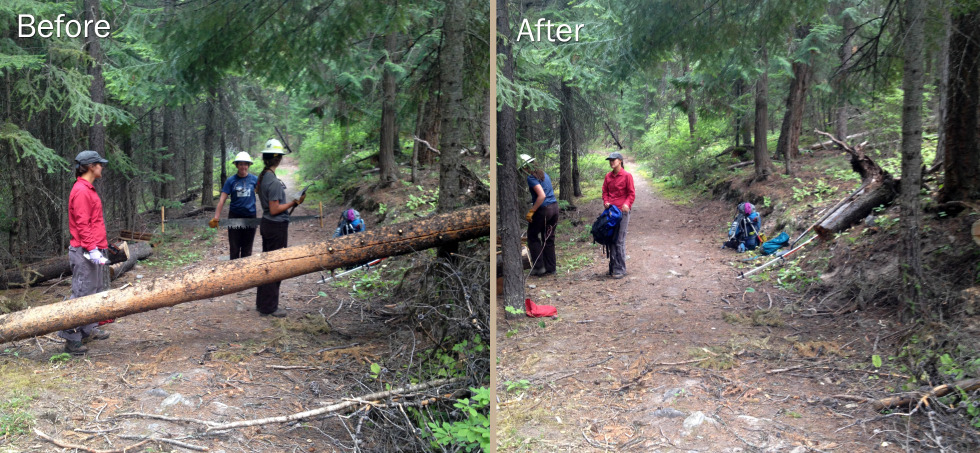On a regular old Tuesday in August, my coworker Zia and I explored the Lolo National Forest with the Selway-Bitterroot Frank Church Wilderness Foundation ’s (SBFC) two Wilderness Interns and their Crew Leader. A long-time NFF grant recipient, the SBFC received funding from our Matching Awards Program for this year’s Wilderness Ranger Intern program .
The team at SBFC was kind enough to invite us along as Interns Erica and Julia started their last “hitch” of the season outside of Lolo, Montana. Most hitches, or backpacking trips, last seven days. This one would be a shorter five day hitch.
After our short caravan of cars made it to the trailhead, the girls, along with their crew leader Coby, needed a few moments to get ready for five days in the Wilderness. Beyond the basic necessities of hiking and camping, the team also took the various tools and supplies needed to do their job: a crosscut saw, shovel, handheld saw, hard hats, clippers, trash bags and more I’m sure I’m forgetting.
Erica and Julia prep for their last hitch of the season.
I stood there with my small day-pack with a sandwich and water, and I felt as if I should be carrying 20 more pounds just to fit in with the group. To provide some assistance as we headed up the trail, Zia carried the crosscut saw, affectionately named Tinkerbell, and I carried the shovel. We figured if they had to carry these tools for five days, we could at least carry them for half a day.
Not too long after we began hiking beneath towering pine trees along the cool air from Lolo Creek, we encountered our first barrier along the trail – a fallen log. Julia and Erica gratefully put down their packs and evaluated the situation. Eager to help, Zia and I began sawing off the small branches while the girls put the handles on the crosscut saw.
Erica and Julia cutting a log blocking the trail.
Once the log was ready, Julia and Erica began sawing the log first from the top, and then from the bottom in order to finish the cut. After the triumphant snap echoed through the woods, all four of us worked to pivot and roll it off the trail so that all users would have easy access.

Further down the trail, Erica and I chatted as we hiked. I didn’t even realize that we had stepped over a small log until Julia called out to Erica to make sure she was stopping. As an everyday hiker, I was shamefully unaware of the trail condition and how it not only affects me, but other users. As Wilderness Rangers, Julia and Erica were constantly checking for obstruction on the trail or any barriers users might encounter.
With the second log removed, we continued up the trail and found an undeveloped campsite to inventory. As the Wilderness Interns trek through the forest, they take an inventory of each campsite noting its location, status, amount of use and then decide to either demolish the site or adapt for healthier use.
While the group spent about 20 minutes inventorying and maintaining the campsite, I couldn’t help but think of the scale of the Wilderness System as well as the National Forest System. There must be thousands of undeveloped campsites across the country that may or may not ever be recorded. And while that may be daunting for some, it only instilled wonder at the amount of work and dedication that the Forest Service and hundreds of organizations devote to these special places.
After ascending on the trail a good ways later, we found a fine lunch spot. Before we ate, everyone used a small tool to help cut down small trees along the trail corridor that would otherwise grow to be a nuisance.
Zia cuts small trees away from the trail and admires the nearby huckleberries.
Huckleberries literally sweetened this task. Each time we crouched down to cut or snip a small tree, big, blue and purple berries greeted us. Soon we all were saying, “I’m too distracted by the huckleberries!” Zia and I quickly decided that we needed to eat all of our lunch so that we would have containers to fill with huckleberries on our hike down.
As mid-afternoon approached, Zia and I said our said goodbyes to the team and wished them well for the remainder of their last hitch.
The NFF supports work on National Forests through local organizations across the country. Unfortunately, we are unable to visit each grantee. More than time in the office ever could, our time with SBFC reinforced first-hand why we do what we do.

Coby and I taking a lunch break.
If you like to help us support more on-the-ground restoration like this, click here.

